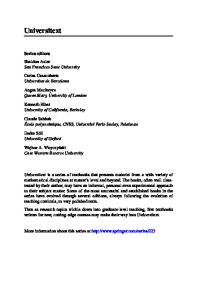Mathematics and Numerics for Balance Partial Differential-Algebraic Equations (PDAEs)
- PDF / 1,561,445 Bytes
- 56 Pages / 439.37 x 666.142 pts Page_size
- 7 Downloads / 349 Views
Mathematics and Numerics for Balance Partial Differential-Algebraic Equations (PDAEs) Wanderson Lambert1 · Amaury Alvarez2 · Ismael Ledoino3 · Duilio Tadeu4 · Dan Marchesin5 · Johannes Bruining6 Received: 25 September 2019 / Revised: 29 May 2020 / Accepted: 6 July 2020 © Springer Science+Business Media, LLC, part of Springer Nature 2020
Abstract We study systems of partial differential-algebraic equations (PDAEs) of first order. Classical solutions of the theory of hyperbolic partial differential equation such as discontinuities (shock and contact discontinuities), rarefactions and diffusive traveling waves are extended for variables living on a surface S , which is defined as solution of a set of algebraic equations. We propose here an alternative formulation to study numerically and theoretically the PDAEs by changing the algebraic conditions into partial differential equations with relaxation source terms (PDREs). The solution of such relaxed systems is proved to tend to the surface S , i.e., to satisfy the algebraic equations for long times. We formulate a unified numerical scheme for systems of PDAEs and PDREs. This scheme is naturally parallelizable and has faster convergence. We do not perform a rigorous analysis about the convergence or accuracy for the method, the evidence of its effectiveness is presented by means of simulations for physical and synthetical problems. Keywords Partial differential-algebraic equations (PDAEs) · Hyperbolic system of equations · Riemann problems · Parallelizable numerical schemes Mathematics Subject Classification 76S05 · 76M10 · 76M20
1 Introduction In many applications, systems of partial differential equations should be supplemented with algebraic restrictions, which represent laws in physics, chemistry, biology or in any other field of application of these equations, see [31,60,73,91,92] and references therein. These equations are called partial differential-algebraic equations (PDAEs). Here, we study systems of PDAEs given by
B
∂t G(U ) + ∂x F(U ) = 0,
(1)
H (U ) = 0.
(2)
Wanderson Lambert [email protected]
Extended author information available on the last page of the article 0123456789().: V,-vol
123
29
Page 2 of 56
Journal of Scientific Computing
(2020) 84:29
Here the variables U = (U1 , U2 , . . . , Un ): Q ⊂ R × R+ −→ V ⊂ Rn are the coordinates of phase space V ; the accumulation and flux functions are G = (G 1 (U ), . . . , G m (U ))T : V ⊂ Rn −→ Rm , F = (F1 (U ), . . . , Fm (U ))T : V ⊂ Rn −→ Rm ; the algebraic relationships are represented by the vector function H = (H1 (U ), H2 (U ), . . . , H p (U ))T : U ⊂ Rn −→ R p . Equation (1) is a system of partial differential equations and Eq. (2) is a system of algebraic equations. We assume that the functions G, F, H are sufficiently smooth. In the first part of this work, we obtain theoretical results about the partial differentialalgebraic equations of first order (1), (2). The solution for such PDAEs for certain models are obtained from index theory, see [16,18,23,42,69,70] and refe
Data Loading...











